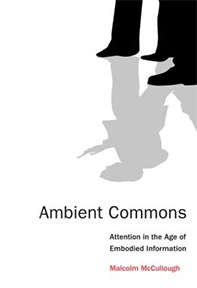By Svetlana Alpers
This book puzzled me from the start: Does it offer a solution to the problems of our times or it is itself a symptom of them? It is one of those subtly written general interest books by a teacher of architecture published by MIT press. Strange Details by Michael Cadwell (which I reviewed for The Key Reporter in 2007), concerned the use of particular materials by four canonical architects. The mortality of human building was essential to the author’s point of view.
What a difference a few years on into the 21st century has made.
McCullough, a professor of architecture, urban planning and now, in addition, of the media arts, is concerned with people who spend their time looking at a screen or rather, at multiple screens. His view that architecture is part of our common ambience takes off from that, the new human condition. By arranging spaces and configuring how we move and behave architecture helps us to act in groups. The implication is that it can take us away from the solitary situation of staring at screens:
“Amid escalating experience of flickering low-resolution ephemera, carefully composed duration and rest may seem welcome. This makes architecture’s greatest asset its persistent high resolution.”
The argument (see the title) is for an ambient experience of built forms. On such an account, it would seem that architecture is not viewed in the details, but in the name of what is repeatedly described as “the persistent high resolution of the built environment.” But the author is interested in details. He focuses in on the light cast on a simple stone wall. And he illustrates the point with a small black and white photograph accompanied by the practical suggestion that one study such a thing or keep it as a background all through the day.
In the chapter “Frames and Facades,” the window aspect of screens becomes the subject of attention. Once again it is the angle of the inquiry that surprises: a teacher of architecture and urban planning is trying to make cultural sense of a world largely experienced at second hand through the mediation of multiple window-like screens. He remarks that the physical portal remains the most vivid threshold of all and goes on to remark that “there is little so regrettable about modern building as the loss of windows that open.” That is true. But it struck this reader as a nonsequitur. What is that observation doing here?
To answer the question with which I began: This book is powerful testimony to the difficulties there are in trying to understand the technological culture of which we are part. Its confusions and its muddles are ours and they remain. Before his conclusion entitled “Epilogue: Silent Commons,” McCullough suggests that our best defense lies in the details of everyday life: “As with food, so with information, it helps to value the slow and the local.” Views of food and of eating are culturally relevant. But judging from the few carefully chosen images printed in this book (among them are a Walker Evans photo of signage and the portal of St. Trophime in Arles), it is not slow and local eating, but slow and local looking that is at the heart of the matter. The new technologies have not taken away our eyes.
Svetlana Alpers, an artist, critic and renowned art historian, is professor emerita of the history of art at the University of California, Berkeley and a visiting scholar in the Department of Fine Arts at New York University.




